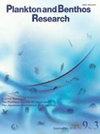Duobrachium sparksae(incertae sedis Ctenophora Tentaculata Cydipida):在波多黎各海岸3910米深处发现的底栖栉水母的一个新属和新种
IF 0.9
4区 生物学
Q4 MARINE & FRESHWATER BIOLOGY
引用次数: 6
摘要
2015年4月10日,在波多黎各西北偏北的瓜哈塔卡峡谷的阿雷西博露天剧场,一种未描述的栉水母的三个个体在大约3900米深的海底被观察到移动。栉号乐器是与众不同的;有两个突出的触手臂的,沿触手面向外观察时呈矩形,沿气孔面向外观察时呈圆形的。每个触手臂产生一个可扩展的触手,带有长度和分布均匀的短触手。有一条栉水母似乎是用它的两条柔韧的长触须和从它的口端伸出的两条细丝,把它固定在海底的。栉水母的整体形态表明它属于有问题的、非单系的栉水母目,但强健的触须更让人联想到栉水母的底栖物种,尤其是栉水母科和栉水母科的底栖物种。尽管大多数栉水母在成年形态中不具有栉行,但本文所描述的新物种所具有的特征,栉虫科的物种在成年形态中保留了栉行,并且能够有限地游泳。这里描述的物种很容易与所有其他已知的栉虫物种区分开来,并且可以将其起源追溯到Platyctenida起源附近的一个分支。本文章由计算机程序翻译,如有差异,请以英文原文为准。
Duobrachium sparksae (incertae sedis Ctenophora Tentaculata Cydippida): A new genus and species of benthopelagic ctenophore seen at 3,910 m depth off the coast of Puerto Rico
On April 10, 2015, three individuals of an undescribed species of ctenophore were observed moving just above the seafloor in the Arecibo Amphitheater inside the Guajataca Canyon, north-northwest of Puerto Rico at a depth of approximately 3,900 m. The ctenophore is distinctive; having two prominent tentacle arms, a body that is rectangular when observed laterally along the tentacular plane, and rounded when observed laterally along the stomodeal plane. The tentacle arms each give rise to an extensible tentacle bearing short tentilla of uniform length and distribution. One ctenophore appeared to be anchored to the seafloor by its two long flexible tentacles, as well as by two filaments exiting its oral end. The overall form of the ctenophore suggests classification within the problematic, non-monophyletic order Cydippida, but the robust tentacle arms are more reminiscent of benthic species of Platyctenida, particularly those of families Lyroctenidae and Ctenoplanidae. Whereas most platyctenid ctenophores do not possess ctene rows in their adult forms, features that are possessed by the new species described herein, species of Ctenoplanidae retain comb rows as adults and are capable of limited swimming. The species described herein is easily distinguishable from all other known species of Ctenophora and may trace its origin to a lineage diverging near the origin of Platyctenida.
求助全文
通过发布文献求助,成功后即可免费获取论文全文。
去求助
来源期刊

Plankton & Benthos Research
Agricultural and Biological Sciences-Aquatic Science
CiteScore
1.30
自引率
0.00%
发文量
32
期刊介绍:
Plankton and Benthos Research is a peer-reviewed journal publishing quarterly original papers, reviews and notes dealing with any aspect of the biology and ecology of planktonic and benthic organisms and their interactions with the environment in any aquatic system, and is open to all scientists around the world. Submission of a paper is held to imply that it represents an original contribution not previously published and that it is not being considered elsewhere.
 求助内容:
求助内容: 应助结果提醒方式:
应助结果提醒方式:


